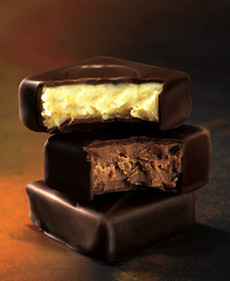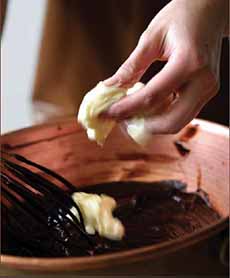

Ganache, a blend of cream and chocolate, can be additionally enhanced with any flavor in the rainbow. The ganache-filled chocolates above, from John & Kira’s, are a NIBBLE Top Pick Of The Week.
March 2005
Last updated October 2025
|
 |
Chocolate Glossary
Terms & Definitions: Ganache & Other Chocolate Terms With G
On this page, you’ll find terms like ganache, German chocolate, gianduja, and grand cru chocolate. If you think we should consider chocolate terms and definitions other than those we have provided, or you’d like to suggest additional words for inclusion, click on the Contact Us link on this page. Also enjoy our 70+ other food glossaries.
Click on a letter to visit other glossary pages.
a b c d e f g h i j k l m n o p q r s t u v w x y z
This glossary is protected by copyright and cannot be reproduced in whole or in part.
GANACHE
A velvety smooth blend of chocolate and cream, often with butter added, that is usually dipped in chocolate and rolled in cocoa powder and sugar or other coatings to make a truffle. It’s often used as a center for bonbons (see the top photo). Ganache can be made from dark, milk, white chocolate, and the newer ruby and blonde/dulcey varieties. It can be flavored with chocolate, coffee, liqueurs, extracts—virtually any flavor that inspires the chocolatier. Using more chocolate than cream yields a firmer ganache, whereas more cream than chocolate yields a softer, more velvety mixture. Ganache can be beaten with butter and used to fill and frost cakes and pastries (ganache beurre or ganache soufflé), and in its liquid state can be poured over cakes and pastries as a glaze. The word means “imbecile” in French. Learn more about how ganache got its name.
|
You may see the term “chocolate ganache.” Since all ganache is chocolate-based, “chocolate ganache” is technically redundant. It’s one of those cases where the modifier has become so common that people use it anyway. That said, “ruby chocolate ganache” or “white chocolate ganache,” for example, do require the modifiers.
|
|
You may see the term “chocolate ganache.” Since all ganache is chocolate-based, “chocolate ganache” is technically redundant. It’s one of those cases where the modifier has become so common that people use it anyway. That said, “ruby chocolate ganache” or “white chocolate ganache,” for example, do require the modifiers.
In the photo at right: Adding butter to basic chocolate ganache (chocolate and heavy cream) makes it more fluid for frosting or filling (photo © Recchiuti Confections). |

|

White chocolate ganache. Here’s the recipe *photo © Three Oliver Branch).
GARNISSAGE
The French term for filling a chocolate shell using a piping bag.
GERMAN CHOCOLATE or GERMAN’s CHOCOLATE
A sweet baking chocolate developed by an Englishman named Sam German for Walter Baker & Company of Dorchester, Massachusetts, manufacturer of Baker’s Chocolate, in 1852. He thought it would be more convenient for bakers, since the sugar was already added. It was called German’s Chocolate in his honor. In 1957, a Texas homemaker submitted the recipe for German’s Chocolate Cake, today generally called German Chocolate Cake, to a Dallas newspaper. A chocolate sour cream layer cake with a coconut pecan topping and filling, it has become a popular recipe. The recipe most likely did not originate with her, as the style of cake was popular at the time.
GERMPLASM
The collection of genetic resources of an organism, a plant’s DNA.
GHANA
A prime growing region for cacao that is bold, assertive, and dark-toned. Most of it is Forastero, but with a low level of bitterness. Common flavors are pure cacao, coffee, and tobacco.
GIANDUJA or GIANDUIA
Also called hazelnut praliné, a smooth nut paste made of roasted and finely ground hazelnuts and chocolate, and sugar, conched together. It can also be made of almonds. Gianduja was invented in the 19th century in Turin, in the Piedmont region of Italy (not surprisingly, Piedmont is the major hazelnut-producing area of Italy). History says that because of the Napoleonic blockade, chocolatiers were unable to obtain enough cacao from South America. What was available was extremely expensive. So they started to incorporate bits of roasted hazelnuts to make the chocolate more affordable. The first gianduioto, later called gianduja, was produced in 1865. Gianduja was originally made with cocoa powder, although today, milk and dark chocolate are used.
GOURMANDISES
The French word for “sweets,” gourmandises (goor-mun-DEEZ) can include the non-chocolate items sold by a chocolatier (i.e., not bonbons, truffles, or chocolate bars), such as chocolate-dipped fruit, dragèes, marshmallows, mendiants, nougatine, pâte de fruit,s and other items we might think of as gourmet candy.
GRAND CRU CHOCOLATE
Chocolate created with beans from a particular area or region, i.e., single-origin chocolate. It can either be a blend (e.g., Criollo and Forastero) or a single variety of beans, as long as the beans come from the one origin. The origin can be closely defined geographically, e.g., the island of Trinidad, or more broadly, e.g., the Caribbean. The term was coined by Valrhona, which launched the first single-origin bar in 1986, Guanaja 70%, a mix of Criollo and Trinitario beans, and defined the origin as South America. Their Jivara Lait milk bar is also from South American beans; their other Grand Cru bars come from Caribbean and Madagascan beans. What Cluizel calls 1er [Premier] Cru chocolate, from specific plantations, is called Estate Grown by Valrhona. To add to the confusion, in the wine industry, from which this terminology is taken, a Grand Cru wine is of better quality than a Premier Cru wine. But the reverse is true, given these chocolate definitions: Cluizel’s 1er Cru chocolate, which is single estate, is of higher quality than Valrhona’s Grand Cru, which is only single origin. See also premier cru chocolate and single-origin chocolate.
GRAIN
(1) The pattern of crystallization of a chocolate bar’s components (cocoa butter, cocoa liquor, sugar), which can be observed on a cross-sectional basis, when a bar is broken in two. (2) Another term for the cacao bean or seed.
GRINDING
After the beans leave the roaster, they go to the grinding room for the mechanical process of pulverizing the roasted cacao nibs into the chocolate liquor. The nibs, which are about 53% cocoa butter, pass through a millstone, which extracts the fat (the cocoa butter) and separates the cocoa mass, or chocolate liquor.
GRIOTTE
(Gree-UT) French for Morello cherry.
Continue To Next Page: Terms With H To L
Go To The Article Index Above
Lifestyle Direct, Inc. All rights reserved. Images are the copyright of their respective owners.

|






